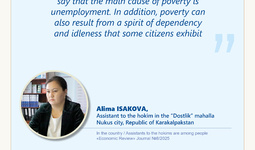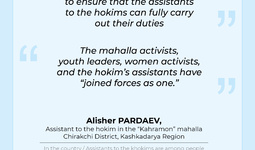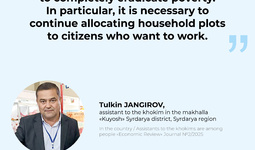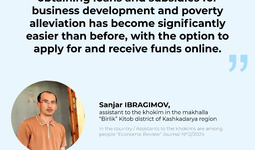– Tell us about your professional career and how you came to your current position. What did you do before, and what skills help you perform your duties effectively?
– Since August 29, 2022, I have been working as the assistant to the hokim of the Karakul District in the Mirzaka’la Mahalla Citizens’ Assembly, focusing on entrepreneurship development, employment, and poverty reduction. I began my career in 2012 as a teacher at the Karakul District College of Oil and Gas Industry. From 2013 to 2016, I headed the operations department at the Karakulgaz ta’minoti branch, and in 2016–2017, I served as its chief engineer. Between 2017 and 2021, I worked as the Head of the Liquefied Gas Supply Service in the Karakul District Department of the Bukhara Regional Hududgazta’minot. From 2021 until August 2022, I was a production supervisor at the joint venture Epsilon Development Company. I can confidently say that the experience I gained and my direct work with people have been invaluable in my current role.
– Please describe the location of your mahalla, its infrastructure, and employment opportunities.
– The Mirzaka’la Mahalla is located about 20–25 kilometers from the center of Karakul District. The population is primarily engaged in agriculture and livestock breeding. The mahalla has 1,125 households, 1,952 families, and a total of 7,266 residents. It hosts two kindergartens, one school, and one medical center. The internal road network extends for 27.8 kilometers.
At the beginning of 2022, there were only three business entities in the mahalla; now there are 40, including four production workshops. The number of able-bodied but unemployed people at the beginning of 2022 was 376. To promote women’s employment, we established a children’s headphones production workshop employing over 30 women, with an average monthly income of 3–3.5 million sums. We have also implemented professional training programs for the unemployed and provided preferential loans. In addition, we encourage residents to develop skills for efficient use of household plots.
– What was the most difficult challenge at the beginning, and how did you overcome it?
– When I was appointed to this position, my first thought was whether I would be able to connect with the people in such a remote mahalla and achieve tangible results. Naturally, there were doubts and fears. However, my ten years of professional experience and acquired skills helped me overcome them. From the very beginning, I made an effort to build trust with respected community members and elders. I personally visited every household, met residents, and identified their skills and interests to involve them in targeted projects.
– What are the main development drivers and priorities for the mahalla? Why were these areas chosen, and what measures are being taken to accelerate their growth?
– Given the abundance of household plots and pastures in the desert zone, and the fact that over 60% of households raise livestock, we identified animal husbandry as the key growth driver. Households are provided with preferential loans for livestock breeding. Two entrepreneurs have been selected for implementation: Ne’mat Rakhmonov, who is expanding pedigree livestock production and supplying affordable and high-quality cattle to residents, and Jasur Khamroev, who is working on a project to import pedigree cattle and process meat products.
– What opportunities exist for entrepreneurship development in your mahalla? How many new businesses have been established, and how many individual entrepreneurs are employed?
– Our President has created all the necessary conditions for entrepreneurship to thrive at the mahalla level. The district hokim is responsible for providing infrastructure to citizens wishing to start or expand their businesses, while the hokim’s assistant and the bank head are responsible for financial support.
During my tenure as hokim’s assistant, several projects have been launched, including eight retail stores, a children’s headphones production workshop, an “Akfa” frame manufacturing workshop, a furniture workshop, a bakery, five catering facilities, four feed shops, three butcher shops, a mini-market, a car wash, two auto repair shops, two plumbing stores, three beauty salons, two barbershops, a carpet weaving workshop, a water filtration workshop, and more. Out of a total of 37 business entities, eight are enterprises, and 29 are individual entrepreneurs.
– Could you share a case where you helped a family or a young entrepreneur and made a real difference in their lives?
– One example is the family of Istam Tukhtaev. The family of five relied on day labor, earning about 2 million soums per month, or roughly 400,000 sums per person. We helped the head of the family secure a permanent job at the forestry department with a salary of 2 million sums per month. One of the children, a person with a disability, was also capable of working, so we provided him with an electric cargo tricycle “Ant” worth 15 million sums. He now earns 100,000–150,000 sums per day - around 3 million per month. We also provided livestock to the family, helping women gain employment. Today, their total family income has reached 5–5.5 million sums, or about 1–1.1 million per family member.
Another example is Mukhiddin Shukurov, who had worked abroad for several years. After returning home, he received a preferential loan and opened a small restaurant in the mahalla, where the entire family is now employed.
– Based on your experience, what are the main causes and factors of poverty?
– When I started working in the Mirzaka’la Mahalla in 2022, the poverty rate stood at nearly 40%, or more precisely 38.5%. Our analysis showed that poverty stemmed not only from remoteness and lack of employment opportunities but also from a dependency mindset - the belief that the state would always provide support. Over the years, we have helped change this mindset while creating new jobs within the mahalla. As of September 1, 2025, the poverty rate has decreased to 6.1%.
I must emphasize that it is impossible to lift a poor family out of poverty simply by giving them a small loan. It is essential to identify enterprising individuals and, when appropriate, provide them with larger loans. This helps them create jobs for others and gradually lift entire families out of poverty.
– What issues do residents most often turn to you with?
– It would not be an exaggeration to say that residents come to the hokim’s assistant with all kinds of problems. People see this position as a direct representative of the hokim in the mahalla, so they seek help on various matters. In such cases, we listen carefully and, depending on the issue, refer them to the relevant mahalla staff. This teamwork allows us to resolve citizens’ problems efficiently. If the issue is beyond the mahalla’s authority, we escalate it to the district hokimiyat.
The full version of the interview is available at: here
Jamoliddin Turdimov, CERR
"Economic Review" Journal №9/2025





















leave a comment